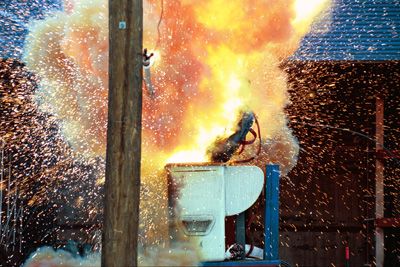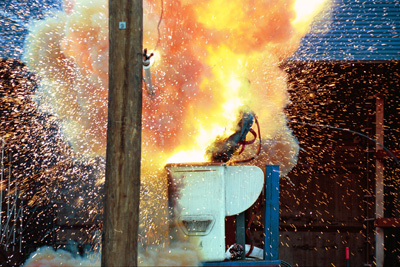
Making Sense of Protection Requirements for Open-Air Arc Flash Hazards

Electric utility workers face complex, high-risk electrical hazards nearly every day. Information about shock hazards – which may come from impressed voltage, residual energy, induction, objectionable current flow in a grounding system or stored energy – has been taught to many of us for quite some time, as have the methods of assessing them.
On the other hand, arc flash hazard assessments are still relatively new to us. In the past, most of us knew that an arc flash could potentially occur during the course of performing our tasks, but the level of the flash and the PPE requirements – other than wearing 100 percent cotton – were not seriously considered in our day-to-day activities until approximately 15 to 20 years ago. To provide more concrete guidelines, OSHA published new regulations in April 2014, with more recent enforcement dates. Instead of making a best guess about PPE, the industry now has a reasonable approach to providing adequate PPE for utility employees who are tasked with performing open-air work. Once a utility completes the required arc flash analysis, develops a policy based on the analysis results and adequately conducts training for affected field personnel, the job of assessing risk and determining PPE levels can easily be incorporated into the daily job briefing. The goal is to make the assessment data easy to access and understand in order to provide effective protection for all workers.
Causes and Severity Levels of Arc Flash Events
An arc flash is the result of either a short circuit during which two energized parts of different potentials (phases) make contact, or a ground fault where an energized part and a grounded conductive part of a different potential make contact. An arc flash event may be caused by a failure of electrical apparatus, potentially due to lack of maintenance, or by worker error, perhaps due to an employee moving conductive parts near energized parts or leaving conductive tools in an energized work area. It’s important to note that differences in potential must always be effectively isolated by distance (air) or insulated barriers.
The severity of an arc flash event and the distance the arc flash will travel depend on four factors; these factors should be part of an effective arc flash hazard assessment.
1. The available bolted fault current. This is a calculated value based on source data.
2. Clearing time of the protective device. The clearing time is associated with the time-current curve of the fuse or breaker operating first in the event of a short circuit or ground fault. Maintenance of breakers and relays is critical for accurate arc flash data; the equipment must operate as designed and within the time-current curve parameters. The incident energy level is directly proportional to clearing time.
3. Impedance between the point where the arc flash occurred and the protective device. Although higher impedance values will lower the available fault current, it will take longer for the protective device to operate or open. This also will cause the arc flash to be greater and reach out farther.
4. Distance from the worker. Distance can provide an effective risk-reducing method for workers. For example, if you increase the length of a shotgun stick from 6 feet to 10 feet, this may lessen the incident energy to a workable level where only an arc face shield with daily arc flash clothing and appropriate gloves are required, instead of an arc-rated hood and higher-rated arc flash clothing. Distance is your friend during an arc flash event.
It’s important to note the differences between single-phase and three-phase arc flash levels, and open-air versus in-a-box events. Three-phase arc flash levels in open air may be up to three times those of a single-phase arc, whereas in a box, they could be more than 12 times a single-phase arc, as cited by OSHA in the preamble to the 29 CFR 1910.269 and 1926 Subpart V final rule. Once the dielectric strength of the air is compromised from a voltage source as little as 277 volts, the air becomes ionized (conductive). For 480-volt services, this usually causes significant damage due to higher available fault currents at this lower voltage and the closeness of terminals, as is the case with a 480-volt self-contained meter.
Electric utilities must reasonably determine the arc flash boundary and arc flash level at the working distance. This can be done through data collection and using IEEE 1584 standard-based software for voltages up to 15 kV, and a different calculation method for higher voltages using software such as ARCPRO, which OSHA has specifically recommended. Analysis results should be concise and simple to use by both utility and contracted electrical workers in the field.
NFPA 70E vs. OSHA Regulations
The NFPA 70E standard has been around for close to 40 years, although many of us had never heard of it until perhaps 20 years ago. It was developed at the request of OSHA to assist with promulgating the 29 CFR 1910 Subpart S regulation published in the early 1980s. OSHA references NFPA 70E for medium- and low-voltage work, particularly when work requires enclosures such as power plants or facility panels. The arc flash boundary defined by NFPA for working in a box is the point at which the arc flash will cause a second-degree burn, or 1.2 cal/cm². For open air, OSHA opted to go with 2 cal/cm² as an arc flash boundary, citing in the preamble to the 1910.269 and 1926 Subpart V final rule that this incident energy level is not sufficient to ignite cotton clothing. So, in open air, the arc flash boundary is the point at which the arc flash drops to 2 cal/cm². A boundary any closer than this would require a minimum of arc-rated clothing, often referred to as “protective daily wear.” The importance of this boundary has diminished somewhat as most utilities use daily wear as a common practice; however, it is important to consider these hazards in the job briefing to ensure no workers without proper arc-rated clothing go within this boundary.
The levels requiring an arc-rated face shield and a balaclava hood also differ between OSHA and NFPA 70E. As you make your decisions about protecting employees, it is important to remember that utilities are exempt from NFPA 70E, but that exemption is not cast in stone. OSHA has not cited NFPA 70E, but the agency has used language clearly from 70E when citing utilities in arc flash incidents that caused fatalities where there was a lack of protective practices or procedures. OSHA published tables are less strict than NFPA 70E published tables; however, an employer that relies on the OSHA tables is on solid ground. For instance, the NFPA table method for open air requires a face shield at exposures greater than 1.2 cal/cm² and a balaclava hood if the exposure exceeds 4 cal/cm². The open-air requirements for OSHA are a shield at greater than 4 cal/cm² for three-phase exposures and 8 cal/cm² for single-phase exposures. The balaclava hood is required at greater than 8 cal/cm² for three-phase exposures and greater than 12 cal/cm² for single-phase exposures. In addition, OSHA allows the head and face protection to be 4 cal/cm² less than the calculated incident energy level. For open air, OSHA does not require using a full arc flash protective suit when working with electrical enclosures beyond what the shield and balaclava will protect. A 4A suit is not required in open-air work. If work is required at these levels, other methods – such as hot-sticking or de-energizing – are required.
OSHA provides Appendix E in 1910.269 for the employer. It should be noted that Appendix E lacks the disclaimer found in several appendices indicating that the material is voluntary. Appendix E has detailed guides and tables the employer can use to formulate an arc flash protective program. To determine your working distance using the OSHA guide, use Table 4, “Selecting a Reasonable Distance from the Employee to the Electric Arc.”
Substation gang-operated switching may require estimates of the shortest distance from the switch to a few feet above the operating handle to determine a common open-air distance.
As noted earlier, once an arc flash or incident energy analysis is complete, the information should be formatted in such a way that field personnel can easily understand and use it in order to choose the appropriate PPE. This data should be incorporated into the company safety manual for ready access.
Collect and Question
To summarize what’s needed for arc flash hazard and risk assessments, first collect the appropriate data and then ask the following questions at each job briefing:
• What is our working distance based on the task?
• What is the arc flash boundary?
• What is the arc flash level at our working distance?
• At what distance are we required to wear a shield?
• At what distance are we required to wear a balaclava hood?
About the Author: Lee Marchessault, CUSP, is the president of Workplace Safety Solutions Inc. He can be reached at lee@workplacesafetysolutions.com.

